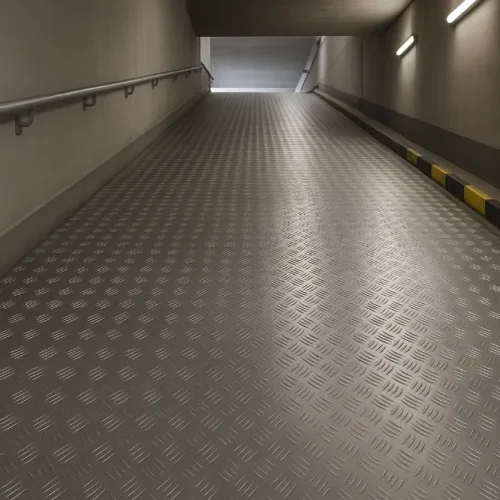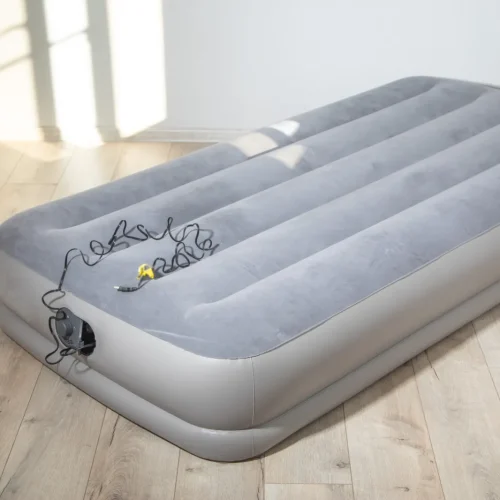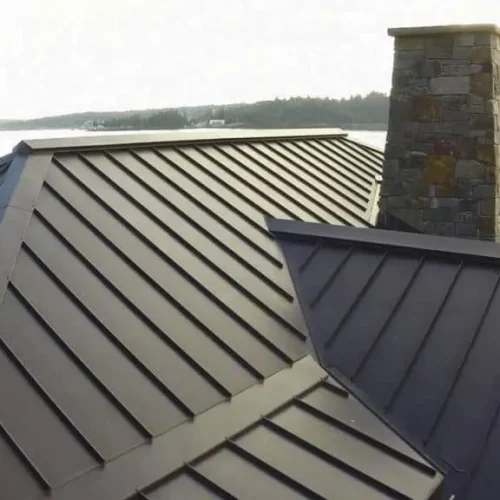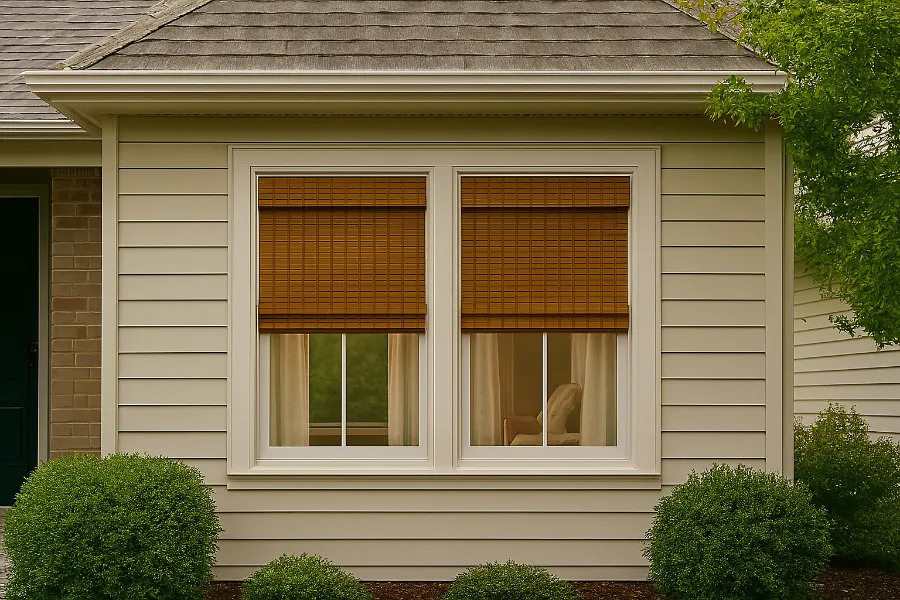
When it comes to window treatments, few options strike the balance between natural beauty, affordability, and functionality quite like hanging bamboo shades. They bring texture, warmth, and a timeless charm that works in just about any room of the house. Whether you’re aiming for a coastal retreat, a cozy farmhouse feel, or a clean modern look, bamboo shades can adapt.
But here’s the big question: how should you hang them? Should they be mounted high, just below the ceiling? Or low, inside the window frame for a neat and custom look? Should you choose an inside mount or an outside mount?
This guide breaks down everything you need to know about hanging bamboo shades—from style choices to step-by-step installation, common mistakes to avoid, and tips for pairing them with curtains. By the end, you’ll feel confident enough to dress your windows like a pro.
The Appeal of Hanging Bamboo Shades
Bamboo shades aren’t new, but their popularity has surged in recent years. Why?
- Natural texture: Bamboo instantly adds warmth and depth to a room. The woven patterns filter light in ways fabric can’t, creating a soft, dappled glow.
- Affordability: Compared to wood blinds or custom shutters, bamboo shades are wallet-friendly. You can cover multiple windows at a fraction of the cost.
- Versatility: They complement nearly every design style—coastal, bohemian, traditional, modern, or eclectic.
- Eco-friendly: Bamboo grows quickly, making it a sustainable material choice.
In short, hanging bamboo shades is an easy way to upgrade your windows without overspending.
Hanging Bamboo Shades High vs. Low
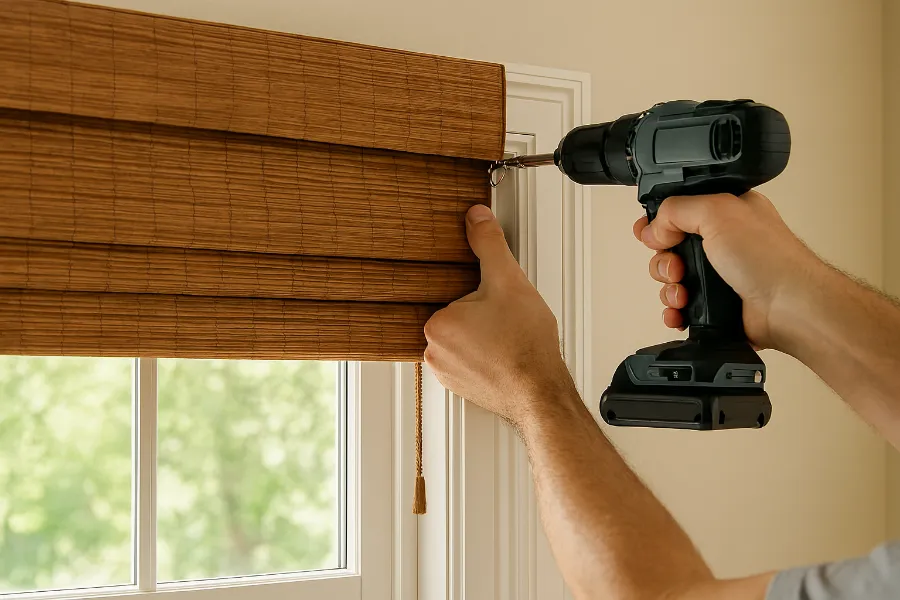
One of the most common design dilemmas is deciding whether to hang shades high or low. Let’s look at the pros of each option.
Hanging High
Mounting bamboo shades near the ceiling—or just under the curtain rod—creates drama.
- Illusion of height: It makes your windows appear taller than they really are.
- Maximizes natural light: When shades are rolled up, they expose more glass.
- Streamlined look: Perfect if you’re combining shades with long curtains.
Designers like Joni Webb of Cote de Texas often favor hanging shades high, arguing it uncomplicates the window dressing while filling awkward gaps between trim and rods.
Hanging Low (Inside the Frame)
On the other hand, mounting shades inside the window frame gives a clean, custom look.
- Showcases trimwork: If your home has beautiful molding, you don’t want to cover it up.
- Tailored finish: Inside mounts look like they were built specifically for your window.
- Better for small windows: Keeps proportions balanced.
Both approaches are stylish—it comes down to your space and the statement you want to make.
Inside vs. Outside Mount
Beyond height, you also need to decide whether to mount inside the frame or outside of it.
Inside Mount
- Fits within the window frame.
- Creates a neat, polished appearance.
- Ideal if your trim is worth showing off.
- Works best with deep window sills.
Outside Mount
- Installed above or around the frame.
- Great for shallow or uneven frames.
- Can make a small window look larger.
- Offers better light-blocking if paired with liners.
Tip: If your room already has crown molding or layered drapes, outside mounts usually integrate better.
Step-by-Step Guide: How to Hang Bamboo Shades
Hanging bamboo shades is a surprisingly simple DIY project. Here’s a step-by-step breakdown.
What You’ll Need
- Bamboo shades (sized for your window)
- Measuring tape
- Pencil
- Drill with appropriate bits
- Screws and brackets (usually included)
- Level
Steps
- Measure Carefully
- For inside mount: Measure the width and height of the inside of your frame in three places (top, middle, bottom). Use the narrowest width.
- For outside mount: Measure the desired coverage, typically extending 2–3 inches beyond the window on each side.
- Mark Your Brackets
- Hold the shade where you plan to install it.
- Mark bracket placement with a pencil—both sides should be even.
- Drill Pilot Holes
- Use a drill bit slightly smaller than your screws.
- For drywall, use anchors for extra stability.
- Attach the Brackets
- Screw brackets into place.
- Double-check that they’re level.
- Install the Shade
- Slide the headrail of the shade into the brackets.
- Secure with the provided wing nuts or clips.
- Adjust the Cord
- Test raising and lowering.
- Add a cord cleat for child safety and a cleaner look.
That’s it—you’re done!
Common Problems and DIY Fixes
Even the best shades can come with quirks. Here are the most common issues and solutions:
- Exposed hardware → Remove factory hooks and replace them with smaller ones hidden behind the valance. You can also DIY custom mounts using triangle hooks and screws placed lower on the back of the shade.
- Uneven roll-up → Check cords for tangling. If one side is rolling faster, gently pull the slower side to even it out.
- Lack of privacy → Add a liner. Many bamboo shades come liner-ready, or you can DIY by attaching a fabric backing with Velcro or clips.
- Dangling cords → Instead of wrapping cords endlessly around a cleat, install two screws inside the frame and wind the cord between them for a sleeker finish.
Styling Tips with Bamboo Shades
Bamboo shades are beautiful on their own, but styling them well makes them shine.
- Layer with curtains: Add long linen or velvet drapes to soften the natural texture.
- Mix tones: Choose shades that complement wood floors, rattan furniture, or woven rugs.
- Use seasonally: Go breezy with white curtains in summer, then swap for heavier drapes in cooler months.
- Match hardware: Brass rods and curtain rings pair beautifully with warm-toned bamboo.
For a cohesive look, keep shades slightly wider than the window to create balance.
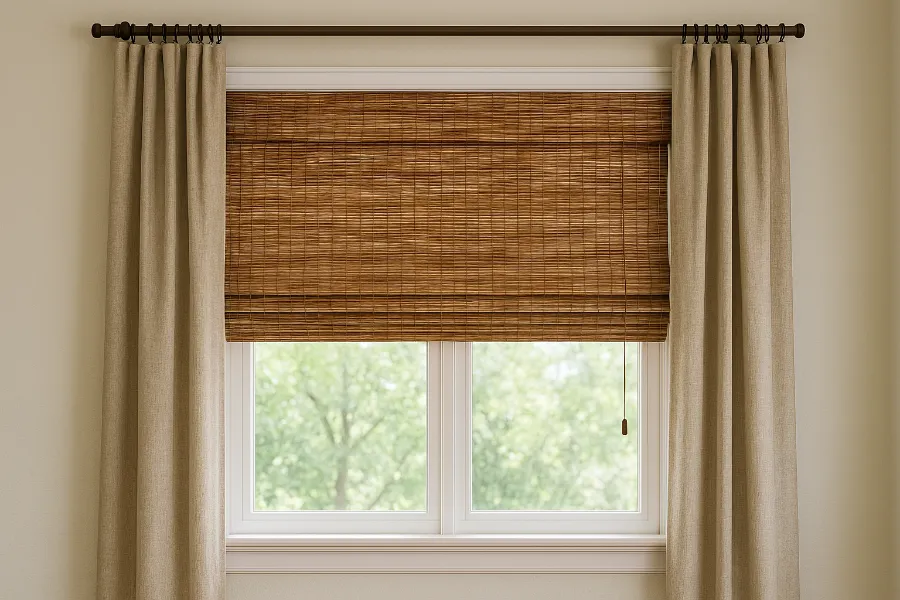
Pros and Cons of Bamboo Shades
Before committing, weigh the benefits and limitations.
Pros
- Affordable compared to wood blinds or shutters.
- Adds natural warmth and texture.
- Easy to install—even for beginners.
- Pairs beautifully with other treatments.
- Simple maintenance (dusting or wiping with a damp cloth).
Cons
- Limited privacy unless lined.
- Can fade or become brittle in strong sunlight.
- Sensitive to moisture—avoid in steamy bathrooms without ventilation.
- Roll-up versions can feel flimsier than roman-style shades.
Most drawbacks are easy to fix with liners, careful placement, or DIY hacks.
Conclusion
Hanging bamboo shades is one of the quickest ways to transform your windows—and your entire room. Whether you mount them high to elongate your walls or inside the frame for a neat, tailored look, they bring natural charm that fabric alone can’t match.
Remember:
- Go high for drama and light.
- Stay inside the frame for trim-friendly elegance.
- Pair with curtains for layers of texture and privacy.
With the right mount and a few styling touches, bamboo shades can go from simple to stunning. So grab your drill, measure twice, and bring home that warm, timeless look.



